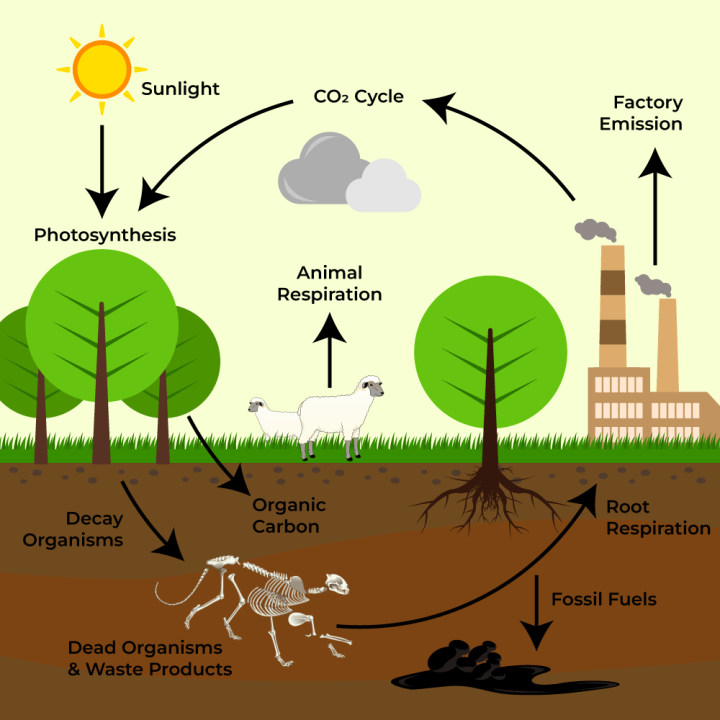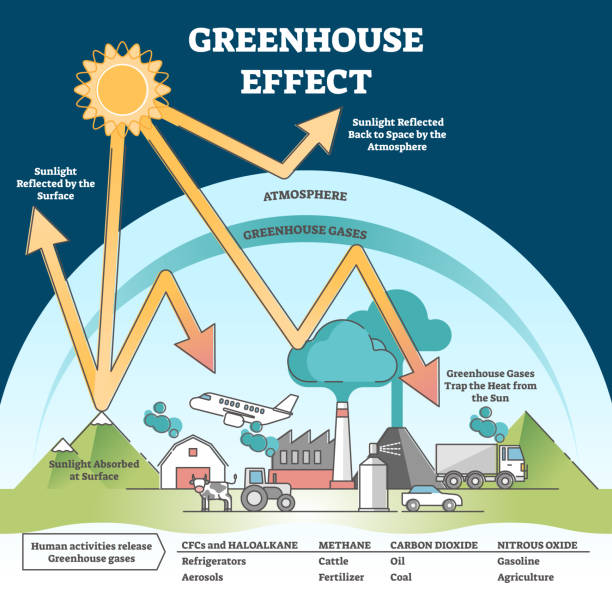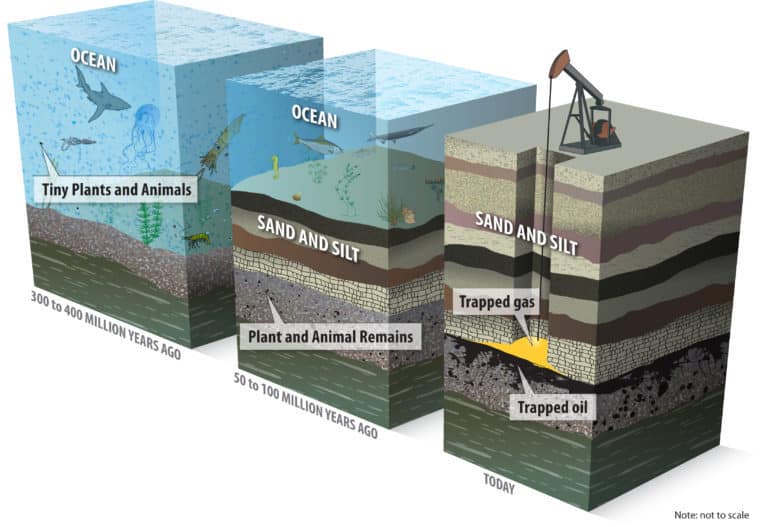The carbon cycle, the greenhouse effect, the origin of fossil fuels, and how carbon affects nearly everything on Earth.
The Carbon Cycle
The carbon cycle is nature’s way of keeping carbon moving—cycling it from the atmosphere to the earth and back again. On earth, carbon is stored in rocks, sediments, the ocean, and in living things. It’s released back into the atmosphere when plants and animals die, when fires burn, volcanoes erupt, or when we burn fossil fuels like coal, natural gas, and oil. This cycle keeps the balance of carbon in check across the planet. But here’s the thing: when one part of the system changes, it impacts the whole cycle. Right now, we’re disrupting this balance—burning fossil fuels is pumping excess carbon dioxide into the atmosphere, and clearing land is removing the plants that naturally absorb it. It’s like pulling a thread in a web—every part is connected. The carbon cycle diagram below shows the flow of carbon along different paths.

Source: BYJU’S
The Greenhouse Effect

In layman’s terms:
The gases in the Earth’s atmosphere help control the Earth’s temperature. Certain gases in the atmosphere, like carbon dioxide, trap heat in the atmosphere, keeping our Earth beneath it warm — much like a manmade greenhouse does with the plants inside it. Thus the term “greenhouse gas” was born.

The effect was therefore dubbed “the greenhouse effect”.
It all starts with sunlight, which is a form of energy. Land and water absorb most of the sunlight that reaches the Earth. The rest is reflected back to space. The Earth’s surface warms up, then gives off energy in a different form, called infrared radiation. This energy travels back towards outer space. Greenhouse gases trap some of this energy in the atmosphere before it can escape, making the Earth warmer.
We do need some greenhouse gases. Without them, our planet (as it is) would be too cold for the current assortment of plants and animals to live. Our current ecosystems have evolved over millions of years to give rise to the plants and animals we see today. However, people (specifically, industry) are adding extra carbon dioxide and other greenhouse gases to the atmosphere. This is why we often hear the term “industrial revolution” in relation to climate change and global warming.

Whenever we drive a car, use electricity, or make a product in a factory, we use energy. Much of this energy comes from burning oil, gas, and coal – what we call fossil fuels. Burning these particular fuels creates large amounts of carbon dioxide. Releasing these extra greenhouse gases into an atmosphere traps more heat, making the whole planet warmer – essentially enhancing the greenhouse effect.
On a small scale, this may not be an issue. The planet is quite adaptable, and is able to effectively process a small amount of extra greenhouse gases — essentially putting them through the planet’s typical carbon cycle. However, the planet has not quite evolved to properly process the amount of extra greenhouse gases currently escaping our industrial processes and being released into the atmosphere.
Warmer temperatures lead to effects like changing rain and snow patterns, rising sea levels, melting glaciers and ice sheets, and much more. This is all happening because we are overloading the atmosphere with excess greenhouse gases. By making the greenhouse effect stronger, we’re upsetting the Earth’s natural balance, warming our planet at a faster rate than the planet can adapt to.
Source: US EPA
The Origin of Fossil Fuels
Carbon affects Earth’s climate and life. Carbon is present in deep layers of the Earth’s crust, in the soil, and in our oceans. It is also in the air as the planet-warming gas carbon dioxide. Carbon is in all living things — including us!
Our planet is like a great carbon machine moving carbon around in an endless cycle. Plants pull carbon out of the air to grow. Animals get carbon by eating plants or other animals. Dead plants and animals leave carbon in the soil. When they decay, the majority of that carbon eventually gets returned to the air. Carbon moves between the air and ocean in the same way, slowly accumulating in Earth.
All living things contain carbon, and when plants and animals die, their carbon doesn’t just disappear. Over millions of years, the remains of these organisms can become buried under layers of soil and rock. With enough heat and pressure, they transform into substances like coal, oil, and natural gas. These substances are essentially the fossilized carbon of long-dead life forms. Thus the term “fossil fuel” was born.

How Carbon Effects Nearly Everything on Earth
Carbon affects nearly everything on Earth because it is the fundamental building block of life, forming the basis of all organic molecules like DNA and proteins, and also plays a crucial role in regulating the planet’s temperature as a greenhouse gas in the atmosphere, impacting climate and ecosystems through the carbon cycle; essentially, without carbon, life as we know it wouldn’t exist on Earth.
As rocks weather, carbon moves from the air to the ocean where it combines with calcium dissolves in water and forms limestone. Volcanic eruptions returns this carbon to the atmosphere through very natural processes like volcanic eruptions. However, about 150 years ago, humans began mining fossil carbon and burning it for energy to power our homes, factories, and vehicles. Today, we release carbon into the air more than 100 times faster than natural processes return it to Earth. In other words, unsustainably.

How carbon affects different aspects of Earth:
- Oceans: Excess carbon dioxide absorbed by the oceans causes ocean acidification, impacting marine life, especially coral reefs.
- Weather patterns: Rising global temperatures due to increased carbon dioxide can lead to more extreme weather events like hurricanes and droughts.
- Plant growth: While some plants may initially benefit from increased carbon dioxide, long-term impacts on ecosystems can be disruptive.
- Biodiversity: Climate change caused by carbon emissions can lead to species extinction and shifts in geographical distribution of organisms.
If rely on historical natural processes, it will take thousands of years to remove the excess carbon from the air. That doesn’t even consider the additional carbon we continue to expel into the atmosphere every day.




